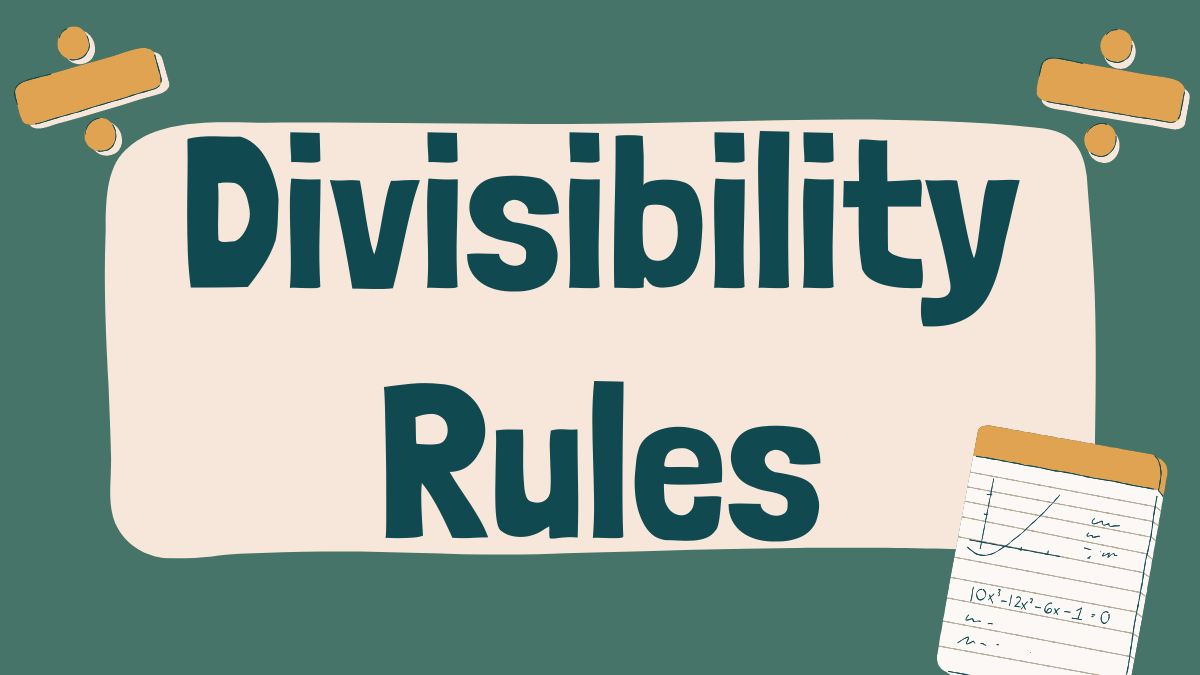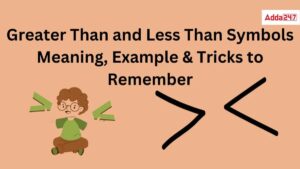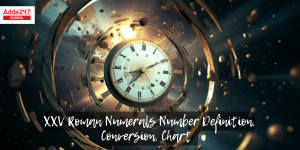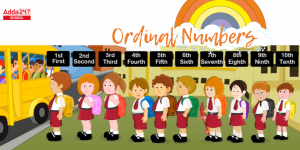The Divisibility rule also known as the divisibility test is one of the key concepts in Mathematics that finds its applications in day to day life. The divisibility rules are used to find whether a number is divisible by a particular number or not without actually performing the division operation. To help students learn the divisibility rule, we have provided the divisibility tests from 1 to 13 in this post.
Divisibility Rules
Divisibility rules or Divisibility tests have been introduced to simplify and speed up the process of division. Learning the rules of division in Math or memorizing the divisibility tests from 1 to 20 will improve students’ problem-solving abilities.
For instance, the rules of divisibility for 13 enable us to determine which numbers can be evenly divided by 13. Some numbers, such as 2, 3, 4, 5, are governed by simple rules that are easy to comprehend. However, the rules for 7, 11, and 13 are slightly intricate and require thorough understanding.
Divisibility Tests
Some people find mathematics challenging. Sometimes, it is necessary to use shortcuts and quick methods to solve Maths problems quickly and easily, without having to do lengthy calculations. This is where divisibility rules or divisibility tests come into picture.
It will also assist students in achieving higher grades in examinations. These rules serve as an excellent illustration of shorthand methods. In this article, we will explore the principles of division in Mathematics through numerous examples.
Divisibility Rules Definition
Divisibility tests in Mathematics, as their name indicates, aid in determining if a number is divisible by another number without performing the division process. If one number can be divided evenly by another number, the result will be a whole number with no remainder.
Since not every number is evenly divisible by every other number, they will always have a remainder other than zero. These particular rules assist us in finding the true divisor of a number solely by examining the number’s digits.
Divisibility Rule of 1
All numbers can be divided by 1. There are no conditions for the divisibility rule of 1. No matter how big the number is, dividing it by 1 will result in the same number. For instance, the number 3 can be divided by 1 and the number 26539435 can also be divided by 1 without any remainder. That is, 1 is the universal divisor.
Divisibility Rule of 2
A number is always divisible by 2 if it is even or if its last digit is 0, 2, 4, 6, or 8. Take into account the number 508. Simply divide the number 8, which is the last digit, by 2. If the number 508 is divisible by 2, it means the last digit is 8.
Example: 25802, 4564, 90030, etc. are divisible by 2
Divisibility Test of 3
The rule for determining if a number is divisible by 3 is that the sum of its digits must also be divisible by 3.
Think about a number, 308. In order to determine if 308 can be divided by 3, add up the individual digits (3+0+8= 11). Next, verify if the total is able to be divided by 3. If the total is a multiple of 3, then the initial number is divisible by 3 as well. Because 11 does not divide evenly into 3, 308 will also not divide evenly into 3. Likewise, 516 can be divided evenly by 3 because the total of its digits (5+1+6=12) is a multiple of 3.
Example: Take the number – 90453
Sum of its digits = 9 + 0 + 4 +5 + 3 = 21
21 is divisible by 3 as 21 = 3 × 7.
Therefore, 90453 is also divisible by 3.
Divisibility Rule of 4
If a number’s last two digits are divisible by 4, then the number is a multiple of 4 and can be completely divided by 4.
Example: Given number is 456832980,
Here the last two digits are 80 that are divisible by 4 i.e. 20 × 4 = 80.
Therefore, the total number is divisible by 4.
Divisibility Test of 5
Numbers ending in either 0 or 5 are always divisible by 5. That is, numbers whose last digit is either 0 or 5 is always divided by 5.
Example: 500980, 345675, 9005643210, 12345678905 etc.
Divisibility Test of 6
Numbers that can be divided evenly by both 2 and 3 can also be divided evenly by 6. If the sum of the digits of a number is divisible by 3 and the last digit is even, then the number is also divisible by 6.
Example: Take the number 10008,
The given number has 8 at one’s place so is divisible by 2
The sum of 1, 0, 0, 0 and 8 gives the total 9 which is divisible by 3.
Therefore, 10008 is divisible by 6.
Divisibility Test of 7
Understanding the rule for divisibility by 7 can be a bit complex, but it can be comprehended by following the steps provided.
Step 1: Multiply the last digit of the given number by two.
Step 2: Subtract the result from the remaining number.
Step 3: If the number is 0 or a multiple of 7, then the original number can be divided by 7. Otherwise, repeat step 2 until you have left only two digits left in the given number
Step 4: If the result obtained after subtraction of the double of last digit is 0 or a multiple of 7, then the original number can be divided by 7. Otherwise, it is not a multiple of 7.
Let us understand the above rule by an example
Let us check if 1073 can be divided by 7 or not
- From the rule stated remove 3 from the number and double it, which becomes 6.
- Remaining number becomes 107, so 107-6 = 101.
- Repeating the process one more time, we have 1 x 2 = 2.
- Remaining number 10 – 2 = 8.
- As 8 is not divisible by 7, hence the number 1073 is not divisible by 7.
Divisibility Rule of 8
If the last three digits of a given number are divisible by 8, then the entire number is completely divisible by 8.
Example: Let us check if 49008 is divisible by 8 or not.
Taking last three digits of 49008, ‘008’ which is divisible by 8, therefore, the number 49008 is divisible by 8.
Divisibility Test of 9
The rule for determining if a number is divisible by 9 is like the rule for divisibility by 3. In other words, if the total of the number’s digits can be divided by 9, then the number can also be divided by 9.
Example: 918, 5067, 8190, 9369, etc. are divisible by 9.
Consider 909
The sum of its digits = 9 + 0 + 9 = 18.
18 is divisible by 9(18 = 9 × 2). Therefore, 909 is also divisible by 9.
Divisibility Rule of 10
A number that ends in 0 is divisible by 10 according to the divisibility rule for 10.
Example: 40, 790, 3690, 364830, 293040, etc.
Divisibility Test of 11
If the difference of the sum of alternative digits of a given number number is 0 or a multiple of 11, then the number is also evenly divisible by 11. That is, if the difference between the sum of digits in odd positions and the sum of digits in even positions is either 0 or a multiple of 11, then the given number will be divisible by 11.
Example: Check if 264482240 is divisible by 11 or not
Adding up the numbers situated in the even positions, such as 0th, 2nd, 4th, 6th, and 8th, i.e., 2 + 4 + 8 + 2 + 0 = 14
Adding the numbers in odd positions like the 1st, 3rd, 5th, and 7th, i.e., 6 + 4 + 2 + 4 = 14
Difference of both these sums = 14 – 14 = 0
The complete number 264482240 is divisible by 11 if the difference between the sum of digits in even place values and the sum of digits in odd place values is 0 or divisible by 11 after calculating. In this case, the result is zero, (14-14) which is able to be divided by 11. As a result, 264482240 can be evenly divided by 11.
Divisibility Rule of 12
In order for a number to be divisible by 12, it must be divisible by both 3 and 4 at the same time. Therefore, the rule of divisibility by 3 and 4 is combined to determine if a number is divisible by 12.
Example: Let us consider the number 3276
Checking the divisibility by 3, 3 + 2 + 7 + 6 = 18, which is divisible by 3.
Thus 3276 is divisible by 3.
As 76 is the last two digits of 3276, and 76 is divisible by 4 (76 = 4×19).
Thus, 3276 is divisible by 4 as well.
As 3276 is divisible by both 3 and 4 simultaneously, thus 3276 is divisible by 12 as well.
Divisibility Test of 13
To determine if a number is divisible by 13, add four times the last digit to the remaining number and repeat until a two-digit number is reached. Now verify whether the two-digit number can be divided by 13 or not. If the number can be divided by 13, then it is divisible by 13, otherwise the number is not divisible by 13.
Example: Check if the number 333957 is divisible by 13 or not
Unit digit of 333957 is 7,
(4 × 7) + 33395 = 33423
(4 × 3) + 3342 = 3354
(4 × 4) + 335 = 351
(1 × 4) + 35 = 39
(1 × 4) + 35 = 39
Reduced to two-digit number 39 is divisible by 13.
Therefore, 33957 is divisible by 13.
Divisibility Rules form 1 to 20 in Table (Chart)
chart of divisibility rules from 1 to 20:
| Divisor | Divisibility Rule |
|---|---|
| 1 | Any number is divisible by 1. |
| 2 | A number is divisible by 2 if the last digit is even (0, 2, 4, 6, 8). |
| 3 | A number is divisible by 3 if the sum of its digits is divisible by 3. |
| 4 | A number is divisible by 4 if the last two digits form a number divisible by 4. |
| 5 | A number is divisible by 5 if the last digit is 0 or 5. |
| 6 | A number is divisible by 6 if it is divisible by both 2 and 3. |
| 7 | Double the last digit, subtract it from the rest of the number. If the result is divisible by 7, so is the number. |
| 8 | A number is divisible by 8 if the last three digits form a number divisible by 8. |
| 9 | A number is divisible by 9 if the sum of its digits is divisible by 9. |
| 10 | A number is divisible by 10 if the last digit is 0. |
| 11 | A number is divisible by 11 if the difference between the sum of digits in odd and even positions is divisible by 11. |
| 12 | A number is divisible by 12 if it is divisible by both 3 and 4. |
| 13 | Multiply the last digit by 9 and subtract it from the rest. If the result is divisible by 13, so is the number. |
| 14 | A number is divisible by 14 if it is divisible by both 2 and 7. |
| 15 | A number is divisible by 15 if it is divisible by both 3 and 5. |
| 16 | A number is divisible by 16 if the last four digits form a number divisible by 16. |
| 17 | Subtract 5 times the last digit from the rest of the number. If the result is divisible by 17, so is the number. |
| 18 | A number is divisible by 18 if it is divisible by both 2 and 9. |
| 19 | Multiply the last digit by 2 and subtract it from the rest. If the result is divisible by 19, so is the number. |
| 20 | A number is divisible by 20 if the last digit is 0 and the second last digit is even. |
Determine the Divisibility Rules for 4 and 25 and Prove that they Always Work
Divisibility Rule for 4:
A number is divisible by 4 if the last two digits of the number form a number divisible by 4.
Proof:
Consider a number
N expressed as
N=100a+b, where: a is the part of the number excluding the last two digits.
b is the number formed by the last two digits (i.e.,
b is between 0 and 99).
Since
N=100a+b, we note that 100 is divisible by 4:
100a÷4=25a
So,
N is divisible by 4 if and only if
b is divisible by 4. Thus, the divisibility rule for 4 works because the divisibility of the entire number by 4 depends only on the last two digits.
Divisibility Rule for 25:
A number is divisible by 25 if the last two digits of the number form a number divisible by 25.
Proof:
Consider a number
N expressed as
N=100a+b, where: a is the part of the number excluding the last two digits.
b is the number formed by the last two digits.
Since
N=100a+b, and 100 is divisible by 25:100a÷25=4a
So,
N is divisible by 25 if and only if
b is divisible by 25. Since
b can range from 00 to 99, the only possible values of
b divisible by 25 are 00, 25, 50, and 75. Therefore, if the last two digits form one of these numbers, the entire number is divisible by 25.
In conclusion, the divisibility rules for both 4 and 25 depend on the last two digits of the number, and the proofs show that these rules will always work.











 Greater Than and Less Than, Equal to Sig...
Greater Than and Less Than, Equal to Sig...
 XXV Number- XXV Roman Numerals Definitio...
XXV Number- XXV Roman Numerals Definitio...
 Ordinal Numbers: Meaning, Examples, Appl...
Ordinal Numbers: Meaning, Examples, Appl...














